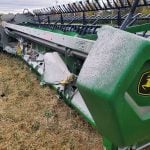An estimated 25 per cent of North America’s mint oil is now the product of a southeastern Alberta farming business, but don’t get the idea that commercial mint production is a job for the faint of heart.


Quattro Ventures grows mint for the essential oils market and had a lot to learn about the agronomics for this specialty crop

Dust from the disease can ignite to cause combine fires; producers advised to frequently clean their equipment

Experts discuss pests and pathogens canola growers will want to watch for in 2024

At harvest, spore buildup can coat equipment, reducing visibility and creating a potential fire hazard